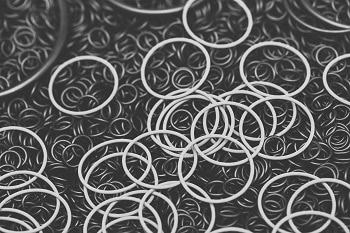HNBR-HYDROGENATED NITRILE RUBBER
HNBR is a highly saturated elastomer produced by special hydrogenation of nitrile butadiene rubber (NBR). Since its creation in the 1930’s, the petroleum-based synthetic rubber, NBR has long been the standard for general purpose, low cost and low heat applications while FKM (fluorcarbon)has been the choice for higher heat.
In the 1980’s, HNBR was introduced as an alternative between NBR and FKM (fluorcarbon). While NBR is inexpensive, it only has a temp range of -30°F to +250°F. FKM has a higher temp range,15°F to +400°F, but it can be cost prohibitive. HNBR offers a compromise between the two with a temp range of -20°F to +302°F. It also offers a higher tensile strength, higher operating temperatures, and excellent resistance to chemicals and ozone. Since its development, HNBR has been polymer of choice in air conditioning systems and many other sealing applications.
Before choosing which compound may work best for your application, don’t forget the role that the fluid, operating temperature,and pressure play in a healthy operating environment. We’ve made a list of the pro’s and con’s of HNBR below.
HNBR Advantages
- Wide Temperature range
- Abrasion resistance
- Resistance to weather, ozone, fuels, oils, sour gas, steam, fats, automotive fluids, and extended service life
- Typically green in color or easy identification
- Available in both o-rings or various hydraulic cylinder packings
HNBR Disadvantages
- Higher Cost
- Limited resistance to aromatic oils and polar organic solvents
- Poor electrical properities and poor flame resistance
Industries Served
- Oil and Gas
- Automotive
- Medical
- Heavy Construction
Sources:


